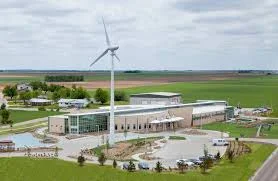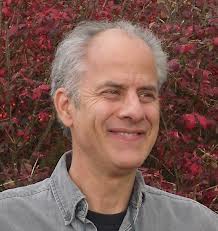NOTE: This interview excerpt is transcript only
Photo Credit: Association for Sustainability
““What we’re capable of doing individually is astonishing, but what we’re capable of doing together is magical.”
”
On the evening of May 4, 2007, the residents of Greensburg, Kansas were hit with a historic crisis that they transformed to extraordinary possibility when the first recorded EF5 tornado - estimated at 1.7 miles wide traveling at 205 mph - left near total destruction in its wake. Sparking a vision that would turn the town into a model for the nation and the world, community members mobilized to create a more prosperous future for generations to come by rebuilding the devastated town as a sustainable city. Among the visionary locals who initiated the plan is Daniel Wallach. Daniel, whose background includes founding and running the Colorado Association of Nonprofit Organizations, founded Greensburg GreenTown to facilitate various green initiatives in partnership with the city and community. Supported by GreenTown efforts on the ground, Greensburg designed and implemented a Sustainability Comprehensive Plan that includes running the city on 100% renewable energy 100% of the time and having the most LEED buildings per capita in the United States. In honor of the town's remarkable restorative leadership, Greensburg, Kansas was mentioned by President Obama in his 2009 State of the Union Address and received several awards including the 2011 United Nations Global Green Community Award. In this interview, Daniel illuminates the power of the restorative leadership practices of scaling vision across shared values and deep listening to create openings for possibility.
On Leading Transcript
Seana Lowe Steffen, host: Could you take me to where you were on May 4th, 2007 when the tornado hit, and your thoughts and feelings after you saw the destruction.
Daniel Wallach, guest: It was just an intense, intense storm, and we heard watching the news how Greensburg was in the path of it. … We could see incredible lightening, like non-stop lightening. It was just so intense, so we knew it was a major storm, and there was a lot of fear on the radio and TV. The storm missed us by about two miles, and we were in our storm shelter. The next day power came back in the afternoon and we saw what had happened to Greensburg. And for me it was a sense of, “I really want to do something for the community but I don’t know what,” and (then I) had this light bulb go off: if Greensburg were to re-build as a model green community they would attract resources that would help them do that much more effectively. I had learned in my travels that small towns that weren’t dying were the ones that had distinct identities. … I wrote a concept paper and Kathryn and I took that to the first town meeting which was exactly a week after the storm, under the tent. … Virtually all the town was gone. Nobody could stay here, so nobody had any idea how many people would come back; turned out about 500 people were there and it was very emotional.
Seana: And what happened?
Daniel: The mayor at the time, Lonnie McCollum, talked from the stage and was very emotional and it was very powerful, and he talked about re-building in an environmentally friendly way. And I (thought), “Whoa! This could really happen.” And then I learned that somebody from the governor’s office also had already talked about it, so I introduced myself to a number of key players and gave them a printout of the concept paper and talked about our experience in organizing non-profits, that we’d be interested in championing this if it was something they’d embrace. So that was that first meeting and we had the longest conversation, a 45-minute conversation, with John Janssen who was president of the (city) council at that time, and so when Lonnie resigned two weeks later, John became mayor and John, who is a wonderful model of leadership, was truly unconcerned with getting any credit for anything and he said to me early on, “I want people who are good at doing things to be doing those things.” So he kept making sure I was getting into meetings and he kept validating possible ideas. …Simultaneously we were doing informational interviewing throughout the community and just doing classic community organizing: identifying the real leaders in town, not the political leaders, getting a sense of how they felt about this concept of being identified as a sustainable model. And nine out of ten times I probably heard people say, “You know I’m not a tree hugger.” So in the process it became very clear that the languaging is really important. What are your values? People always open up about what their values are, and there is never a human being whose values don’t tie to a healthy environment. It’s just being able to make that connection in a way that isn’t threatening… It’s a very religious community so being able to talk about stewardship, and why wouldn’t you respect God’s creation in the same way you respect the flag? ... And it’s all about innovation. It’s all about responsibility, conserving; conservatives don’t waste. … they fish, they hunt, they farm, they recycle. They do all these things that we associate with environmentalism but they don’t want to be identified as that, so we help them re-language, re-frame and that became the vision for the community. I watched as the media came to town and would ask questions and invariably they would try to kind of trick people into saying this isn’t something you really believe in, that it’s a gimmick and it’s like, “No, this is of us. There is nobody pulling our strings, you know. This is ours.” And much of what you see at the material level is evidence of that. We could not ever have achieved what we achieved if everybody didn’t go do their part that was part of this bigger vision. And for me again it was a lesson in barn raising, which is a very rural concept, right? That everybody comes together and supports one another in creating something that has been lost in the community, and that in adversity there is a kind of glue that comes out that bonds us. And they know that better in rural areas than we do in urban areas.
Seana: Very powerful.
Daniel: It’s all about communication and connectedness, right?
Seana: Great. So in a relatively short period of disaster recovery time, as well as general development time, Greensburg has done something that’s never been done in the country or the world to our knowledge, right? So what would you say are the keys to Greensburg being able to translate this vision of sustainability to a reality, to the current reality?
Daniel: Vision is what carries us. …when we have a clear vision we’re fed by that vision, we are nourished by it, and we keep being present with it. And the more that we’re present with it the more it draws us toward it and it manifests. I mean, that’s just the whole concept of visualizing. It’s proven. It just works. That’s how we create. So being able to individually and collectively have a vision, it’s very powerful to work collectively on a vision, very powerful, and we don’t do that nearly enough in this country. World War II and the moon shot, there are some examples, but not very many and I don’t know why it takes so much to get there, but it’s so enriching and nourishing. So it’s having that vision. It’s critically important that you have points along the way that you identify as successes. So you have to stop and really digest, even if you haven’t reached the ultimate goal, which you won’t for some time. There are goals along the way and sometimes you recognize them and sometimes you just have to stop and go, “We’re still here and there is momentum,” and just find the things that are happening. It was funny because here there was so much happening so fast that it really took a concerted effort to keep stopping and going, “Okay, another victory to celebrate.”
Seana: What would you have everyone be sensitive to?
Daniel: Their heart, their values, how their actions everyday relate to what they’re most passionate about, what they love most. That none of this environmental destruction, this recklessness would occur if we were sensitized because it’s us. It’s our kids. It’s the very basis of love and we’re just so removed from it in this culture that we do things that are reckless and self-destructive, that are counter to our self-interest consistently. And for people like us who have been through healing, come through a healing crisis, that sensitizes you. When you lose what you think you had, that sensitizes you, … and if you can keep that sensitivity open, you can inject real systemic change into that community.
Seana: What would you hope that everyone could learn from the example and the leadership?
Daniel: I think that anything is possible. I mean, as trite as that sounds, we do forget the truth of that sometimes and we look at problems and think they’re insurmountable, and they never are. We have incredibly profoundly creative spirits and what we’re capable of doing individually is astonishing, but what we’re capable of doing together is magical. And to remember that and to try to facilitate that – again that’s kind of how we’re wired, how we’re designed. We’re to solve problems. We get juice from that, and doing it together is joyous. So to be proactive in relation to problems instead of being reactive is key, because when we’re proactive we feel a power and it makes us rise up. And Greensburg again, just the power of people coming together to carry out a common vision in a way nobody imagined possible. Remember where you are. … My first interview, and I’ve probably done 100, probably 150, my first interview was so exciting because it was this guy from NPR in Topeka and he knew Kansas and one of the first questions he asked was, “Now what makes you think this is possible, because western Kansas is the place where ideas come to die?” I was like, “Okay, I see what we’re up against” (laughs).
Seana: How did you respond, or how do you respond now?
Daniel: Well now is a little different. We can just look at it. At the time I remember being pretty shocked by it but I think I was very positive and just said, “You know people here have come through a lot and they are determined to make something of it and they will.”
Seana: And they did!
Daniel: And they did. There are so many goodies that continue to come to the community. We talk about re-sensitizing, it’s also re-sensitizing to the abundance that we have, that if we are too close to it for too long we take it for granted. There is no way not to do that, so how do you keep re-awakening to the gifts that are in your lap, and we all know of spiritual leaders who lived that and how joyous they are and how that is a secret to happiness.
Share Daniel's Restorative Leadership Message
Click each social media image to download and share! #leadershipmatters #onleading
Translate Vision Into Sustainable Reality
Green Town U.S.A. recounts Greensburg’s inspiring story of resilience, community, and sustainability which began on the evening of May 4, 2007, when disaster struck the quiet Kansas city. A tornado topping all the scales touched down, and in a matter of minutes, Greensburg, which stood for more than 120 years, was destroyed. Greensburg committed to reconstructing itself from the ground up while embracing green technology and building methods, along with solar and wind energy. The new Greensburg stands testament to the values of rural community and the viability of sustainable community redevelopment and energy-efficient living.
Greensburg is an American television series broadcast on the Planet Green television network. The show takes place in Greensburg, Kansas, and is about rebuilding the town in a sustainable way after being hit by the May 2007 EF5 tornado.










